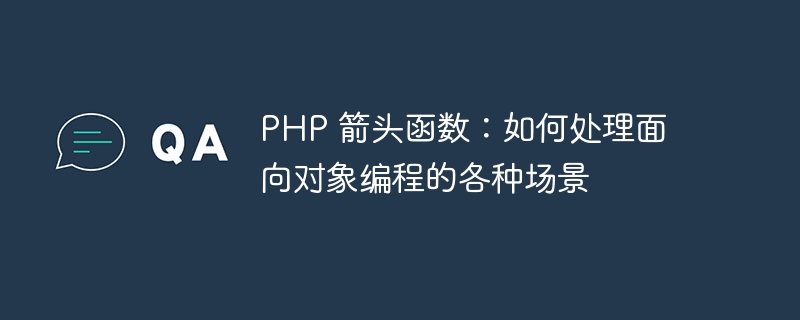Home >Backend Development >PHP Tutorial >PHP Arrow Functions: How to handle various scenarios in object-oriented programming
PHP Arrow Functions: How to handle various scenarios in object-oriented programming
- PHPzOriginal
- 2023-09-13 10:31:441467browse

PHP Arrow Function: How to handle various scenarios of object-oriented programming, specific code examples are needed
Introduction:
Object-Oriented Programming, OOP (abbreviated as OOP) is a commonly used programming paradigm that achieves code maintainability and reusability by encapsulating data and operations in objects. In PHP, we can use arrow functions to handle various object-oriented programming scenarios. This article will introduce the application of arrow functions in object-oriented programming in detail through specific code examples.
1. The basic concept of arrow function
The arrow function is a new feature introduced in PHP version 7.4. It is an anonymous function and its usage form is as follows:
$arrowFunction = fn($arg1, $arg2, ...) => expression;
Arrow function and ordinary anonymous function The difference is that it does not have its own scope and cannot use the $this and static keywords. The main advantages of arrow functions are simplicity and syntactic sugar, which are particularly suitable for handling some simple functional programming scenarios.
2. Application of arrow functions in object-oriented programming
-
Object methods as callback functions
In object-oriented programming, it is often necessary to use the method of an object Passed as a callback function to other functions. Using arrow functions can simplify this process. For example:class Person { private $name; public function __construct($name) { $this->name = $name; } public function sayHello() { echo "Hello, my name is {$this->name}!"; } } function doSomething(callable $callback) { $callback(); } $person = new Person("John"); doSomething(fn() => $person->sayHello());Here, we pass the sayHello method of the Person object as a callback function to the doSomething function. Using arrow functions, we can call $person->sayHello() directly without creating an additional anonymous function.
-
Simplified array callback function
In object-oriented programming, it is often necessary to process arrays, such as using array_map, array_filter and other functions. Arrow functions can simplify the definition of callback functions for arrays. For example:$numbers = [1, 2, 3, 4, 5]; // 原始写法 $squares = array_map(function($n) { return $n * $n; }, $numbers); // 使用箭头函数 $squares = array_map(fn($n) => $n * $n, $numbers);Here, we use the array_map function to square each element of the array $numbers. Using arrow functions, we can directly define a concise callback function.
-
Using external variables in closures
In object-oriented programming, sometimes it is necessary to use external variables in closures. Using arrow functions, we can save the step of using the use keyword. For example:function createMultiplier($n) { return fn($x) => $x * $n; } $double = createMultiplier(2); echo $double(5); // 输出10Here, we use the arrow function createMultiplier to return a closure that multiplies $n by $x. When using arrow functions, we do not need to use the use keyword to specify the external variable $n, it will be automatically bound.
Summary:
Through the above examples, we can see the application of arrow functions in object-oriented programming. It can simplify the handling of scenarios such as object methods as callback functions, callback function definitions for arrays, and the use of external variables in closures. However, it should be noted that arrow functions have their own limitations, such as the inability to use the $this and static keywords. Therefore, when dealing with complex object-oriented programming scenarios, you may need to use traditional anonymous functions.
Note: All sample codes in this article are based on PHP 7.4 version.
Reference link:
- PHP Manual: Arrow Functions (https://www.php.net/manual/en/functions.arrow.php)
The above is the detailed content of PHP Arrow Functions: How to handle various scenarios in object-oriented programming. For more information, please follow other related articles on the PHP Chinese website!

